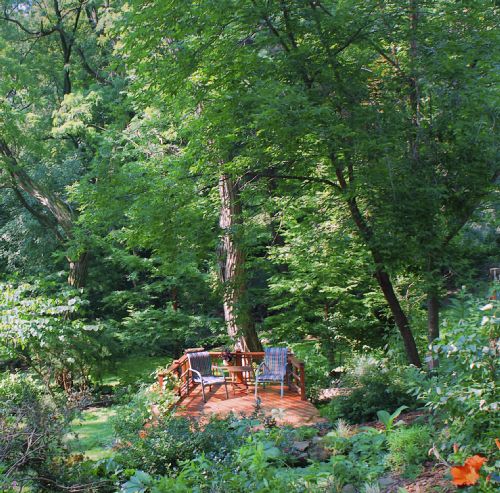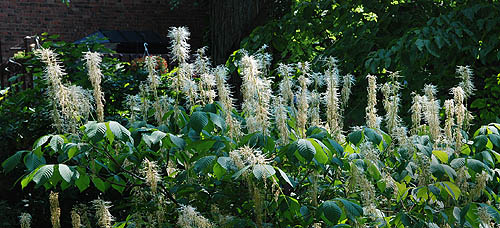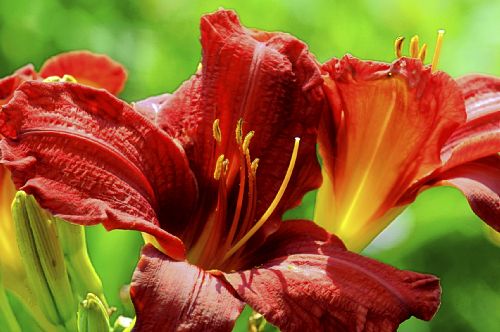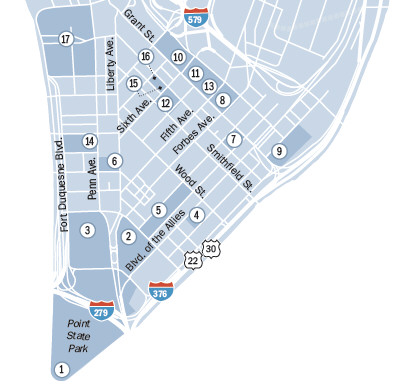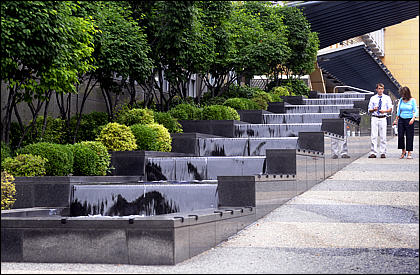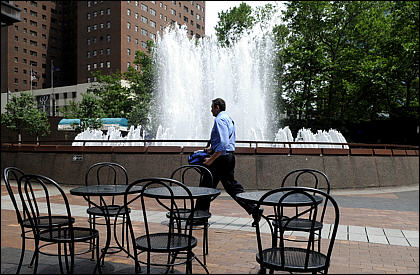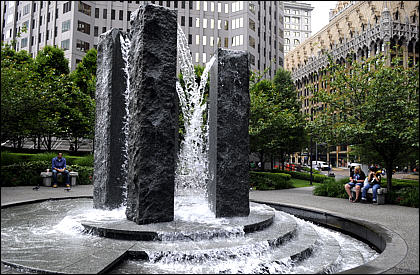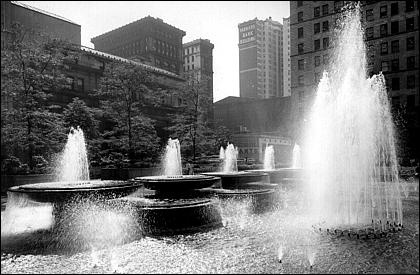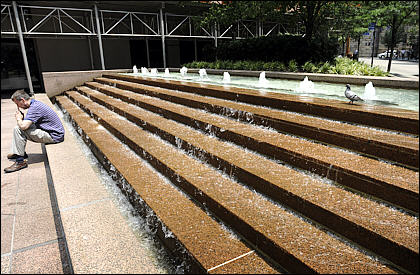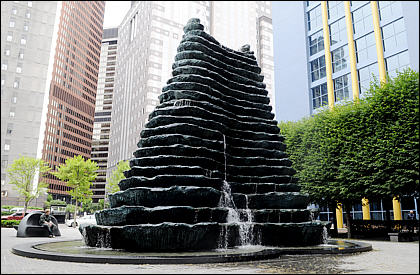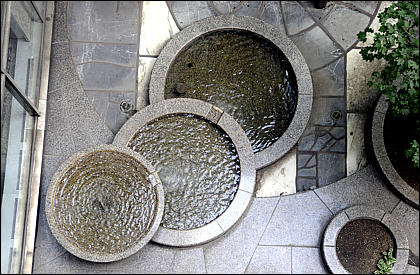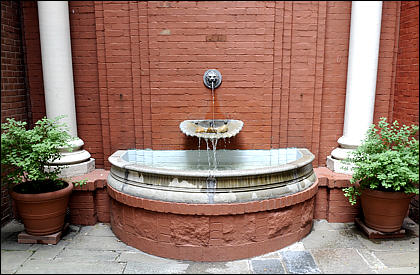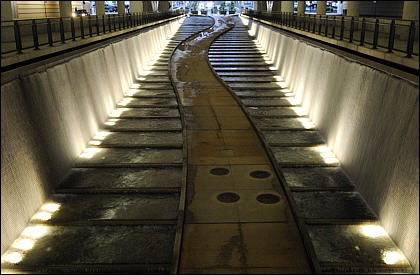
Category Archive: Landscapes
-
Pools, Rivers, Fountains and More Offer Splashing Fun
By Pittsburgh Tribune-Review
Wednesday, July 14, 2010When it comes to cooling off, there aren’t many better or more efficient ways than getting soaked.
There are a variety of pools, rivers, fountains, rides and more available in Western Pennsylvania to take the edge off of even the hottest days — and we’ve certainly had plenty of those lately. So get out there and get wet.
Wave poolsThere’s nothing like getting drenched at one of Allegheny County’s three wave pools. On a sweltering day, few things are more inviting than a heaving expanse of cool blue water, with the afternoon sun dancing on the frothy waves. The county operates wave pools at Settler’s Cabin Park in Robinson, South Park in Bethel Park and Boyce Park in Plum.
The waves are created by a series of chambers concealed behind the rear wall of the pool. They blow compressed air that produces the waves, says Joe Olczak, director of public works. He says they can alter the height of the wave by changing the firing sequence of the chambers. They could make a wave as large as five feet, he says.
“We normally don’t do that because there’s a lot of young kids. We try to keep the waves one to two feet high.”
Settler’s Cabin wave pool is the most heavily used of the three. To beat the rush, go during the week. The weekend rush starts not long after the 11:30 a.m. opening time Friday. No outside food or drinks are permitted, but customers are permitted to bring their own chairs. Inner tubes can be rented for $5, with $1 refunded on the return.
All three pools are open 11:30 a.m. to 7 p.m. daily. Admission is $5 for adults; $4 for ages 13-17; $3 for age 60 and older and ages 6-12; $1 for age 5 and younger. Group discounts are available. Details: Settler’s Cabin Wave Pool, 412-787-2667; South Park Wave Pool, 412-831-0810; Boyce Park Wave Pool, 724-325-4677, or www.alleghenycounty.us/parks/fees/pools.aspx.
— William Loeffler
The big poolsPeople fond of whopping places for a cool plunge can choose from some of the biggest pools in Western Pennsylvania. Admission rates for adults range from $5 to $7.
North Park Pool — a 57,000-square-foot landmark built in the early 1930s — once claimed to be the largest pool in the United States. It offers a 20-foot-tall curved slide, separate baby pool, concession stand, swimming classes and 25-cent lockers in a big, slate-roofed bathhouse. Swimmers can rent flotation tubes, but rafts, belly boards and other flotation devices are prohibited. North Park Pool is on South Ridge Road in McCandless. Hours: 11:30 a.m. to 7:30 p.m. daily. Details: 724-935-1951.
Dormont Pool is longer than a football field and also offers a curved slide, concession stand and swimming lessons, plus water aerobics classes. Dormont Pool is at Banksville Road and Dormont Avenue. Hours: noon to 8 p.m. daily. Details: 412-341-7210.
Ligonier Beach — a 400-by-100-foot pool — opened July 4, 1925, and shares 10 acres with a sit-down restaurant, picnic grove, sand area, snack bar, poolside bar and game room. Entertainer Dean Martin once worked as “a towel boy” at the pool, and bands continue to perform 2 to 6 p.m. Sundays. Feel free to bring your own raft or other flotation device. Ligonier Beach is at 1752 Route 30 East in Ligonier Township, Westmoreland County. Hours: 11 a.m. to 7 p.m. daily. Details: 724-238-5553 or www.ligonierbeach.com.
— Deborah Deasy
State parksPerhaps you’re allergic to chlorine. Maybe you don’t like man-made waves. Or it could be you’d rather not pay to swim.
Three state parks in the region offer cost-effective alternatives to crowded, and sometimes pricey, municipal and public pools.
At Keystone State Park in Derry, Westmoreland County, a 1,000-foot sand beach lies on the northern rim of Keystone Lake. No food, pets, beverages are allowed on the sand. Swimming is available from 8 a.m. to dusk, from mid-May through mid-September.
Moraine State Park in Portersville, Butler County, offers two swimming areas. Pleasant Valley Beach on the south shore of Lake Arthur features a 1,200-foot sand-and-turf beach, with a playground and sand volleyball court nearby. A 550-foot sand beach is the main feature of Lakeview Beach on the north shore. Both beaches have showers, changing rooms and food concessions nearby, and are open from sunrise to sunset, from Memorial Day weekend through Labor Day weekend. No pets are permitted on the beaches.
Raccoon State Park in Hookstown, Beaver County, features an 800-foot, sand-and-turf beach, with a bathhouse and concession stand nearby. Swimming is available from mid-May through mid-September.
All state parks are swim at your own risk; swimming at all state parks is free. Details: www.dcnr.state.pa.us/stateparks/index.aspx.
— Rege Behe
OhiopyleGetting wet is easy around Ohiopyle. But watch out, it can be dangerous, too.
The Fayette County town is in the middle of a great outdoor area featuring mountains, a long bike trail and, of course, the Youghiogheny River. That waterway offers rafting trips that are among the best-known in the Mid-Atlantic area. Even if you stay in the boat, you’re bound to get wet.
The trips that begin near the town explore 7 1/2 miles of the Lower Yough, blasting through Class III and IV rapids. This is not a trip to be taken lightly and safety talks are part of every adventure to make sure rafters know what to do if they are tossed from the boat.
If these rapids are not enough, try trips on the Upper Yough, which is above the reservoir gated at nearby Confluence. This 5-mile trip roars through class V rapids and drops an average on 115 feet per mile. Because this is not dam-controlled these trips usually are spring-oriented when runoff gives the river flow.
But don’t forget the Middle Yough from Confluence to Ohiopyle. This stretch provides a generally placid trip with a few Class I and II rapids. Basically, though, it is a lovely trip through a deep Appalachian valley, the stuff folk songs are made of.
Outfitters such as Wilderness Voyageurs (800-272-4141) or Ohiopyle Trading Post (888-644-6795) handle a variety of trips near Ohiopyle. Prices vary according to the day, the trip, what kind of lunch is offered, or whether a guide is needed or included. They can go as high as $150 on the Upper Yough, $95 for the Lower or around $35 for a float on the Middle.
— Bob Karlovits
Spray parksCommunity swimming pools aren’t cheap to run and maintain, and every year, it seems, there’s a battle to keep more from closing. Another way for kids to cool off during the dog days of summer is the spray park.
Pittsburgh has two — one in Troy Hill that opened last year, and a new one that opened in Beechview this summer.
Spray parks feature an array of different water features, fountains, sprinklers, sprayers and mist-makers, many with sensors triggered by movement. Kids can sprint through the spray park setting them all off, or spend time soaking and redirecting the flow of their favorite features.
There’s no age limit, no worries about falling into the deep end. Children with disabilities — even wheelchairs — can participate.
“The response has been really great,” says Mike Radley, director of Citiparks. “It reaches a large spectrum of kids and neighbors.”
There are two other Allegheny County-run spray parks outside the city, at Round Hill Park in Elizabeth and Deer Lakes Park in Frazier. The one at Round Hill Park is called the Aquatic Playground, and has a farm theme — with fountains and sprayers shaped like pigs, barn doors and tall sunflowers.
City spray parks: Vanucci Playground, Orangewood Avenue, Beechview. 9 a.m. to 9 p.m. daily. 412-255-2539. Goettman Street, Troy Hill. 9 a.m. to 9 p.m. daily. 412-255-2539.
County spray parks: Round Hill Park, Hereford Drive, Elizabeth. 8 a.m. to sundown daily. 412-384-4701. Deer Lakes Park, Creighton Russelton Road, Frazier. 8 a.m. to sundown daily. 724-265-3520.
— Michael Machosky
Amusement parksWhether you’re going to Kennywood or Idlewild, there are guaranteed ways to cool off and get wet as the day gets hot.
On two of Kennywood’s three water rides, you almost certainly will get soaked. On the Raging Rapids, you ride in a round tube with five other people along a winding, bumpy river with at least one waterfall. On a hot day, get on this ride early before the lines get too long, then you’re wet clothes will help keep you cool as you explore the rest of the park.
On the Pittsburg Plunge you ride in a car that holds 20 people. It goes up a hill, around a bend and then, you guessed it, plunges 50 feet into a pool of water, generally drenching everyone inside and those on an observation platform.
The Log Jammer’s ability to soak is a little more iffy. Your best bet is to share your log with three of your heavier friends to get the maximum splash on both the smaller slope in the middle of the ride and the big hill at the end.
At Idlewild, the water fun is found in Soakzone, a large water park that has fountains and slides to fit every level of daring. There are five larger slides, some where you use rafts and some where you slide on your own backside. The hydrosoaker area allows you to spray your friends. Or stand under the tipping bucket as hundred of gallons of waters cascade down. For toddlers, the Little Squirts area has a shallow pool with fountains, waterfalls, and gurgling jets. For those a little older but not yet read for the big slides, Captain Kidd’s Adventure Galley has multiple small slides, jets, waterfalls and its own tipping bucket.
The water features are included in general admission to the parks.
Kennywood, West Mifflin. Hours: 10:30 a.m. until around 10 p.m. Admission: $17.49 to $35.99. Details: www.kennywood.com.
Soakzone, west of Ligonier. Admission: $21.99 to $29.99. Hours: 11:30 a.m. to 6 p.m. Details: www.idlewild.com.
— Susan Jones
SandcastleThere are plenty of places to get wet at Sandcastle waterpark. Enjoy 14 fun-filled waterslides. The Blue Tubaluba slides are Sandcastle’s first dual-rider, enclosed slides. The Boardwalk Blasters body slides are for strong swimmers only because you race down two 25-foot long slides to a soaking surprise ending — a 7-foot free fall into a 12-foot-deep landing pool.
Brave thrill seekers will enjoy the Monster, a free-fall slide, starting 85-feet above the finish, with a gradual slope glide of 25 feet that drops to a steep 60 feet, hitting speeds up to 25 miles per hour.
There is a 20,000-square-foot wave pool. Willie’s Water Works is a pool where children control 20,000 gallons of water by pulling ropes, twisting valves and turning handles that unleash geysers, fountains and sprays. Surrounding it all is the Lazy River, a gently flowing stream a quarter-mile long.
Purchase a season pass and get wet as many times as you like.
Sandcastle, West Homestead. Hours: 11 a.m. to 6 p.m. Mondays-Thursdays; 11 a.m. to 7 p.m. Fridays-Sundays (Memorial Day to Labor Day). Admission: $18.99-$29.99. Details: 412-462-6666 or www.sandcastlewaterpark.com.
— Joanne Klimovich Harrop
MuseumsTwo museums on the North Side have dedicated their top floors to playing in water.
• Bright yellow balls, clear tubes and lots and lots of running water make the Carnegie Science Center’s Exploration Station Junior a popular destination for the 3- to 6-year-old set.
The comfortably child height and brightly colored area is a great place for exploring scientific concepts like using a corkscrew device and wheels to raise water or just splashing around. Oversize blue and yellow vinyl bibs help ward off wet clothing and there’s a small hand dryer for damp spots.
Just outside the preschoolers’ station older kids and adults have their own area for water play and hydraulic exploration. At hip high metal troughs, they can construct water dams or connect clear tubes to direct the flow of water.
Carnegie Science Center, North Side. Hours: 10 a.m. to 5 p.m. Sundays to Fridays and 10 a.m to 7 p.m. Saturdays: Admission: $17.95; $9.95 for ages 3-12. Details: 412-237-3400 or www.carnegiesciencecenter.org.
• The Waterplay exhibit takes up the whole top floor of the Children’s Museum of Pittsburgh. Kids can build a boat to float down the River and make its way through a dam. Or don boots and a slicker and walk through bubbling water jets that you can re-direct by making spouts with interlocking pipes. Better bring a change of clothing, because even the most cautious kid usually gets wet.
Children’s Museum of Pittsburgh, 10 Children’s Way. Hours: 10 a.m. to 5 p.m. Mondays to Saturdays, noon to 5 p.m. Sundays. Admission: $11; $10 for age 65 and older and ages 2-18. Details: 412-322-5058 or www.pittsburghkids.org.
— Alice T. Carter
PPG PlazaThe spurt and splash of the PPG Plaza fountain’s 140 water jets could help you chill even if you just watched them from beneath the shade of one of the plaza’s umbrella-covered tables.
The water forms complex, ever changing patterns as liquid columns soar up to 15 feet around the plaza’s central column.
Kids love the fountain’s flat no-barrier surface that allows them to meander or sprint through the unpredictable eruptions, risking or inviting a good soaking.
Guards enforce the plaza’s clearly posted rules which include no running; no beachwear, towels or sunbathing; no bikes, skateboards or animals; adult supervision of children and no drinking the water.
PPG Plaza is bordered by Third and Fourth avenues as well as PPG buildings 1 and 4, Downtown. The fountain operates every day through Oct. 1 with continuous operation from 6 to 11 a.m., 11:30 a.m. to 2 p.m. and 5 to 10 p.m. and intermittently at 2:30 and 3:30 p.m. Details: 412- 434-1900 or www.ppgplace.com.
— Alice T. Carter
Water stepsGravity does the work at the Water Steps at North Shore Riverfront Park. From a pool in front of Hyde Park steak house on North Shore Drive, just west of PNC Park, the water descends over broad steps of sandstone blocks toward the Ohio River.
Each level provides a restful yet refreshing blend of cool water and warm sun, where you can sit in the stream and take in a spectacular view of Downtown. Straight ahead is the river, on which ducks may be seen enjoying the sight of humans in water.
The steps’ steady yet gentle flow of water fits the idyllic family-friendly environment.
— Mark Kanny
TubingFor the ultimate in sunny day relaxation therapy, set your bottom into an inner tube and allow a gentle river flow to propel you downstream between tree-lined river banks. This past weekend, the water temperature was a perfect 78 degrees.
The Pale Whale Canoe Fleet on the Clarion River in Cook Forest State Park offers tube rentals that include a drive upstream to your put-in. Choose from a two-hour, 2 1/2-mile float ($10 for a single, $18 for a figure-eight double) or the four-hour, 4-mile trek ($14 for single, $26 for double).
The river is a mild family friendly one that averages just 2 to 3 feet in depth. But even so, kids are strapped into life jackets for your set-your-own-pace river ride. Add an extra tube to strap on your cooler — or rent a floating cooler — and the day will be complete. There are plenty of stops — atop rocks or on the river bank — to enjoy a snack and cold drink.
From Pittsburgh, take I-79 north to I-80 east to the Brookville exit. Following Route 36 north, cross the Clarion River Bridge and make a right on River Road. Pale Whale will be on the left. Hours: 9 a.m. to 7 p.m. daily, renting until 4 p.m. Details: 800-680-0160 or www.canoecookforest.com.
— Sally Quinn
-
Greening the South Side: Residents Plant Nearly Two Dozen Street Trees
Wednesday, January 13, 2010
South Side will begin to look greener in the spring thanks to Kim Collins.
Back in March, she and a friend were talking over wine one night, trying to think of something they could do in their community. “And we came up with trees,” says Collins. “I live on Wharton Street and there was, like, one tree on my block.”
Collins, who is the owner and creative director of South Side-based graphic design firm Blue Tomato, worked to create the South Side Pittsburgh Tree Project with the help of neighbors and nearly 45 volunteers.
In October, they planted 21 trees ranging from maples to lilacs on the 1900 block of Wharton Street.
To start the project, Collins researched and found the TreeVitalize program, a partnership between five organizations including the city, county and state and two nonprofits, including the Western Pennsylvania Conservancy. The goal of the program, according to its website, is to “plant 20,000 trees by 2012 throughout the Pittsburgh region in order to improve quality of life and the environment.”
Once assisted by TreeVitalize, Collins and other leaders went door-to-door asking residents if they would water and take care of trees if the South Side Pittsburgh Tree Project took care of planting. Twenty-one residents agreed to this arrangement for the first planting.
Riverset Credit Union aided the project by paying for the website and marketing, as well as a banner on Sarah and 11th Streets that asks, “Want A Free Tree?”
The South Side Pittsburgh Tree Project wants add at least 300 to 400 more trees in the South Side over the next four years.
Currently, 4,500 trees have been planted in Allegheny County through TreeVitalize.
Sign up to receive Pop City each week.
Writer: Pop City Staff
Source: Kim Collins, South Side Pittsburgh Tree ProjectImage courtesy of South Side Pittsburgh Tree Project
-
Rain Barrels and Rain Gardens: Nine Mile Run Watershed Association Looks Ahead
Wednesday, July 14, 2010
This Saturday night, the Nine Mile Run Watershed Association (NMRWA) will celebrate another year of progress at their annual fundraiser.
In lower Frick Park, near the confluence of the Fern Hollow and Nine Mile Run streams, “A Midsummer Night’s Storm” will include food and drink from Point Brugge Café and Make Your Mark Artspace & Coffeehouse. Rick Sebak, the Mon River Ramblers, J. Malls and Hi Top Wrangler will be on hand for the festivities.
The goal will be to raise funds for the association’s environmental stewardship programs, including the Rain Barrel Initiative and Rain Garden Pilot Project.
One of the environmental challenges in the Pittsburgh area is that rain storms cause runoff that brings chemicals and pollutants from our streets and sewers down into the rivers. The Association has been battling that by introducing rain barrels and teaching homeowners to develop rain gardens to keep rainfall on their own property.
“We now have over 1300 rain barrels just in our watershed alone, which is probably one of the highest densities for a rain barrel program in the country,” says Lisa Brown, director of operations and outreach at NMRWA. “Within the watershed, we install and we maintain them. And we continually keep in contact with the rain barrel owners,” to create an ongoing relationship of outreach and teaching.
The Rain Garden project is “sort of a separate project because many, many people don’t necessarily want to use rain barrels. They are interested in something that is, I guess, more aesthetically appealing,” Brown says. “So we teach them to disconnect downspouts and create a rain garden, as part of a suite of options for homeowners.”
Pop City Media
Writer: Melissa Rayworth
Source: Lisa Brown, NMRWA
Images courtesy of NMRWA -
Mount Lebanon Gardener Turns Destruction into Opportunity
Saturday, July 10, 2010By Kevin Kirkland, Pittsburgh Post-Gazette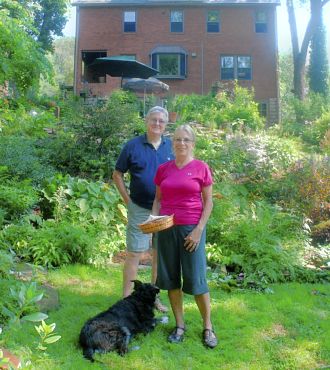
Larry Roberts / Post-Gazette Wes and Nancy Smith will open their garden for the Mt. Lebanon Library's 20th Anniversary Garden Tour.
In more than 25 years of Pittsburgh gardening, Nancy Smith has tested, sometimes fooled and been humbled by Mother Nature.
She has succeeded with plants that supposedly need more sunlight or aren’t supposed to survive our winters. And she has lost perfectly suitable plants and trees to beastly weather, critters big and small and for no earthly reason at all. She tries to see major disasters like falling trees as an opportunity for change.
“It opens something up,” she says.
But the past five months have tested even the most hopeful gardener’s patience.
February’s snowmageddon brought down three large junipers, a chamaecyparis and a Leyland cypress. A great blue heron ate one large koi and more than half of the dozen goldfish in two ponds, and birds and rodents teamed up to steal her entire crop of strawberries. Then, recent high winds brought a neighbor’s 80-foot-tall black locust tree crashing down on a bed between the two ponds.
Despite it all, Mrs. Smith will have her garden looking great for Sunday’s Mt. Lebanon Library Garden Tour. Hers and six other gardens will be open from noon to 5 p.m. You can see more of her handiwork today, when the library holds its garden party in the courtyard that Mrs. Smith and 11 other volunteers have created over the past 10 years.
Everywhere she gardens, Mrs. Smith tries to keep a simple motto in mind:
Destruction is an opportunity for change.
Growing up near Baltimore, she failed in her first attempt at a garden at age 9. She had better luck shortly after she married Wes Smith, another Maryland native. Her parents brought lots of plants from their yard to the rental property the newlyweds shared. They moved to Mt. Lebanon in 1983 and volunteering at the library garden led to classes at what is now Phipps Garden Center. She became a master gardener in 1987 and was one of the leaders in designing and planting the library’s courtyard garden in 2000-01.
Meanwhile, Mrs. Smith was transforming her front and back yard, which once held mostly grass and a pedestrian collection of yews, forsythia, pachysandra and a few large spruce, locust and maple trees. The front still has a little grass nearly hidden by beds packed with interesting cultivars of phlox, sedum, ligularia, boxwood, hydrangea, yellow-leafed caryopteris and other perennials and shrubs. A fast-growing curly willow and red maple provide some shade.
The backyard originally held a concrete patio leading to a grassy hillside. But it soon changed.
“Every year we add something,” Mrs. Smith said.
She adds the plants (she says she’s a reformed “plant hog”) and her husband adds hardscape.
“I build or haul or cut grass,” he said modestly.
One year, Mr. Smith and his two sons-in-law replaced the concrete patio with one made of paver bricks laid in a herringbone pattern. Mrs. Smith created perennial beds around the old brick walls and grill, featuring larkspur, catchfly (Silene armeria), amsonia, New England asters, Joe Pye weed, cleome and an arum with exotic long leaves and giraffe-like spots on its thick stem.
When a willow fell nearby, Mrs, Smith asked her husband to build a pond near the stump. The next year he built a lower pond and linked them with a waterfall. The year the garden was on the Pittsburgh Botanic Garden Tour, he built a deck near the lower pond. He also built a cold frame and all the paths in the backyard.
With each piece of hardscape, Mrs. Smith creates adjoining beds. And as trees or limbs fall, she adds interesting shrubs and trees. She’s planted two metasequoias, a paperbark maple, redbud, fernleaf buckthorn, Carolina silverbell, Virginia juniper, ‘Diablo’ ninebark and a bottlebrush buckeye (Aesculus parviflora) that is just done blooming.
A shady bed near the bottom of the hill features Lenten rose, hostas, goatsbeard, ferns, variegated Solomon’s seal and Allegheny spurge, our native pachysandra.
“I like to do a lot of natives,” Mrs. Smith says, but her garden is not limited to them.
Her advice to gardeners who are just starting is simple: Take classes and talk to other gardeners about plants that do well here. And don’t overdo it.
“You can’t handle more than one new garden per year,” she said. “Otherwise, it’s a full-time job.”
Mt. Lebanon Library’s 20th anniversary Garden Tour runs from noon to 5 p.m. Sunday. The library will have a plant sale and free consultations with Penn State Master Gardeners and a member of the Pittsburgh Rose Society. Tickets are $12 in advance and $15 on tour day at the library. A pre-tour Garden Party will be held from 6 to 8 p.m. today in the library garden courtyard. Tickets are $25 per person and available at the door.
-
Tiny Gardener Designed Her House and Garden to Show Off Beloved Flowers
Saturday, July 10, 2010By Susan Banks, Pittsburgh Post-Gazette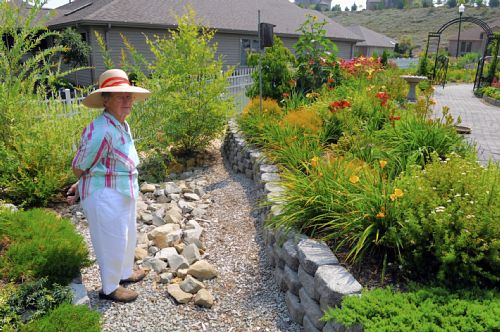
Irene Ciccarelli stands in front of the the willow, birch and pine trees in the catch basin area of her garden in North Huntingdon. Darrell Sapp / Post-Gazette
Overflowing flower beds with lots and lots of color, that’s Irene Ciccarelli’s cup of tea. Her 2-year-old garden, tucked in the new Lincoln Hills housing plan in North Huntingdon, stands out among the restrained landscaping of her neighbors. It’s not that she doesn’t like the neatly manicured plots around her home, she just likes flowers better.
She also likes being able to look out her windows and see flowers, so her garden has been designed to frame the property and be visible from the indoors, with only a small patch of lawn in the front. It’s also designed to be handicapped-accessible in case the energetic 80-year-old ever needs to use a wheelchair to tend it.
In less than two years, this diminutive woman has managed to plan, plant and tend a garden that will be open to visitors today from 10 a.m. to 2 p.m. for the Greenridge Garden Club and Norwin Art League’s 2010 Art in the Garden Tour. Mrs. Ciccarelli’s garden and six others will feature artwork by league members.
Mrs. Ciccarelli, who will be in her garden on the day of the tour, is no stranger to hard work. She recalls hoeing corn during the Depression, and also has fond memories of the flowers that her mother tended at their home in Irwin. The names of those flowers intrigued her and led to her lifelong enthusiasm for plants. This is her fourth garden — she has created three others in different areas of the country where she and her husband lived during their long marriage.
When her husband passed away several years ago, Mrs. Ciccarelli, a retired schoolteacher, moved back here to be closer to family. While staying with her sister, she started looking for a new home that would meet all of her needs. The house she is in now was under construction when she purchased it, allowing her to customize the inside, adding more windows and doors, and also alter the outside hardscape. When moving day came, there was no landscaping, just dirt. She had crummy soil, a drainage ditch and a wickedly steep hillside in the back. In other words, she had a Pittsburgh yard.
She first amended the soil by double-digging the flower beds and adding 10 to 12 truckloads of mushroom manure — by herself. Then planting commenced.
When asked if she had a grand plan, she shrugs and says she made it up as she went along. She did know she wanted continuous color and lots of perennials, which she loves. As inspiration, she used Anne Hathaway’s garden in Shottery, England, considered the quintessential cottage garden. She laughs when she recounts that on a visit to that garden she discovered it takes six or eight full-time gardeners to keep it looking perfectly informal.
Though a neighbor cuts her small patch of grass, Mrs. Ciccarelli tends this garden herself, usually in the early part of the day. The beds are overflowing with coneflowers, bee balm, clematis, heuchera, lady’s mantle, daylilies, liatris, bergenia and more; many are now happily self-sowing. Because she mulches heavily, she hasn’t had to start watering until just this past week.
When asked if she had a favorite nursery, she replied that she buys lots of her plants from the damaged table at Lowe’s. She says it’s a great place to find inexpensive plants that just need a little tender loving care, but she cautions bargain hunters to go early in the morning when the pickings are good.
Sometimes, she’ll splurge on a special specimen such as the Bonica rose planted on a trellis. She found a gate/trellis at a discount store and installed that on the side of the house. Conifers are plopped into the beds to provide winter interest and small ornaments are scattered throughout. Her attention to detail is seen in the garden and in her home, both of which were lavishly decorated for the July Fourth holiday.
Her next big project will be the extremely steep bank behind the house. She has started planting it with shrubs and plans on fencing some of it off to discourage the deer, which invade during the winter.
And while the garden will never be finished, she says, “I’ve accomplished what I set out to do (two years ago). I have year-round color.”
Tickets for the Art in the Garden Tour are $10 and can be purchased at Vargos Hallmark Shops, Norwin Town Square and Norwin Hills Shopping Center; Belaks Flower Shop in Irwin and the Greensburg Garden Center, Greensburg.
-
Pittsburgh Offers Plenty of Refreshing Water Havens During the Summer Months: A Walking Tour of the City’s Fountains and Water Feaures
Sunday, July 11, 2010By Bill Toland, Virginia Linn, Patricia Lowry, Marylynne Pitz and Katy Buchanan, Pittsburgh Post-GazetteOur crown jewel fountain at Point State Park (No. 1 on the map above) is dry until 2012 while it undergoes repairs, and a few others also need work, but there are plenty of other burbling basins to enjoy in the city. Some are old, some are new, some tucked away and some in plain view. But they all make a splash, so put on your walking shoes, follow this guide and discover the cool fountains of Downtown Pittsburgh.
__________________________________________________________________________ 1. Point State Park
DETAILS: When it rose for the first time on July 23, 1974, the fountain in Point State Park sprayed a geyser of water that was 150 feet high.
At its formal dedication that August, the magnificent column of water signified the park’s completion, the importance of rivers to the region’s growth and the city’s first renaissance.
The fountain cost $1 million and the 6,000 gallons of water that circulate through it each minute come from Pittsburgh’s “fourth river,” which flows 54 feet underground. When running, 800,000 gallons of city water recirculate through it daily.
Designed by Ralph Griswold and Charles Stotz, the fountain has experienced its share of problems, including flooding that deposits mud, silt, logs and other debris.
Between 2007 and 2012, Point State Park and its fountain will have been renovated at a cost of $42 million.
“It’s the largest park project in commonwealth history,” said Edward Patton, director of capital projects for Riverlife, a public-private partnership whose mission is to improve the region’s riverfronts.
The fountain’s circular base is 200 feet in diameter. Plans call for cleaning its circular granite rim and adding a second, higher tier over which water will flow into the basin at the rim level. People standing on the great lawn will be able to see the overflow tier.
The plaza around the fountain will be raised 18 inches, making it easy for visitors to sit on the rim and access its water. The sandstone block plaza will be dug up, cleaned and relaid. For the present, the fountain is inaccessible during construction.
2. TrizecHahn Plaza (formerly Equitable Plaza)Bounded by Liberty Avenue, Stanwix Street and Boulevard of the Allies
COMPLETED: 1961
DETAILS: The plaza sandwiched by the former state office building on the west and Gateway Four and the Verizon Building on the east was designed by Simonds and Simonds, Pittsburgh’s renowned landscape architecture firm (now known as Environmental Planning and Design). It features shady pergolas, benches, planting beds and two rectangular, nearly flat fountain basins, one hidden at the back where the plaza segues into a walkway over the Boulevard of the Allies.
A partial redesign of the plaza in 2004 surrounded the fountains, frequently a magnet for kids on hot summer days, with mounds of grasses, roses and coneflowers. Post-Gazette architecture critic Patricia Lowry in 2009 wrote of the redesign: “Part of the geometric-patterned gray and white terrazzo, so striking from above, has given way to a winding path of square pavers that seems more pastoral than urban.”
3. Gateway CenterBounded by Liberty Avenue, Stanwix Street and Fort Duquesne Boulevard
COMPLETED: 1956
DETAILS: When it was dedicated in 1957, city officials baptized it with waters from the Ohio, the Monongahela and the Allegheny. It’s been obligingly accommodating the rumps of lunching workers, arts festival-goers, smokers and, more recently, texters and cell-phone talkers ever since. The fountain, with its bronze vase and turquoise basin, was designed by the prominent New York firm Clarke & Rapuano, which also consulted on Point State Park. At the time it was christened, Post-Gazette files show, it was called the Fountain of the Three Rivers (one of several by that name in the world) though that name does not find itself in general usage.
4. Wood-Allies Garage228 Blvd. of the Allies
COMPLETED: 1985
DETAILS: Completed as part of the public open space component of a city-owned parking garage, “Pittsburgh People” was a favorite project of its creator, Pittsburgh artist Jerry Caplan. Working with terra cotta slabs and sewer pipes, Mr. Caplan created wall reliefs and figures for this sweet little pocket park that connects the Boulevard of the Allies with First Avenue. A large column depicts bas-relief figures in elevators, some modeled after known Pittsburghers such as Mayor Richard Caliguiri and Mr. Caplan’s good friend, artist Donna Hollen-Bolmgren. The artist himself is there, too. Other figures are meant to represent a variety of Pittsburgh types — steelworker, crossing guard, businessman, mother and child. Alas, it did not fare well over the winter; its fountains are not working at present and will not be fixed this year. Part of the wall relief is in need of restoration, too, apparently stained by salt leaching from the clay. The parking authority isn’t sure when the city budget will allow repairs to the concrete foundations and pumps.
5. PPG PlazaBounded by Third and Fourth Avenues one block east of Stanwix Street
FOUNTAIN COMPLETED: 2003
DETAILS: One of the greatest gifts to the people of Pittsburgh has been Henry Hillman’s computer-choreographed fountain built in the middle of PPG Plaza.
It surrounds what former Post-Gazette columnist Peter Leo affectionally dubbed the “Tomb of the Unknown Bowler,” a 44-foot obelisk built in what used to be a rather stark, barren plaza.
But each spring, the plaza gushes to life with a fountain of 140 jets of water illuminated by 280 underground lights. Recirculated water pulses up to a height of 15 feet from the granite floor, delighting children and adults alike who frolic in its lovely coolness.
The fountain was created by WET Design of Universal City, Calif. Mr. Hillman’s gift also covered the cost of converting the space into a popular skating rink each winter, which opened in December 2001 and was designed by IKM Inc.
Mr. Hillman, whose company owns PPG Place, has never revealed the price of the gifts.
6. Heinz Hall PlazaSixth and Liberty avenues
COMPLETED: 1982
DETAILS: The site used to hold a Woolworth’s store; now it’s a summertime alfresco dining space next to Heinz Hall, and water plays a starring role in this production. Officially called the Garden Plaza, it opened on May 7, 1982, part of a larger addition to Heinz Hall that was completed at the same time. In the spring and summer, a waterfall tumbles two stories in the back corner of the plaza, while a fountain burbles in the courtyard.At least, that’s usually the case — but this year the waterfall is turned off and the plaza is closed for repairs. It’s scheduled to reopen for the Pittsburgh Symphony Orchestra’s Bella Notte concert Sept. 16.
The courtyard and waterfall were designed by MacLachlan, Cornelius and Filoni; the kinetic water fountain (four circular platforms spilling water onto each other, called “Quartet”) was designed by London sculptor Angela Conner. Together, they use 10,000 gallons of recirculated water, drawn — as is the case with the Point State Park fountain — from the city’s underground aquifer.
7. One Oxford CentreThird and Grant streets
COMPLETED: 1983
DETAILS: Since One Oxford Centre opened, a soothing three-tiered fountain has graced the southeast corner of a sunken plaza at the office and retail complex.
Its eight plumes of water rise at various heights, providing a pleasant backdrop for patrons relaxing at umbrella-covered tables at the center’s ground-level Easy Street restaurant and Au Bon Pain. The fountain contains between 4,000 and 4,500 gallons of water.
The $100 million One Oxford Centre, a 46-story complex of offices, shops, restaurants, parking and athletic club, kicked off a second renaissance of Downtown development in the 1980s.
It was developed by Oxford Development Co. and designed by St. Louis-based global architectural firm HOK (formerly Hellmuth, Obata, & Kassabaum).
8. Allegheny County Courthouse436 Grant St.
COMPLETED: 1977
DETAILS: Henry Hobson Richardson, architect of the Allegheny County Courthouse of 1888, had intended that the courtyard it encloses be entered by vehicles and drew it as a brick-paved plaza with a watering fountain for horses as centerpiece. No fountain was built, and the courtyard’s wagons and carriages in time evolved into cars on an asphalt parking lot.
In 1976, Katy Flaherty, wife of then-Allegheny County Commissioner Jim Flaherty, floated her idea for transforming it with planters, trees and a fountain. The county couldn’t come up with the money, but when the Sarah Scaife Foundation donated $64,000 to Pittsburgh History & Landmarks Foundation for materials, the county provided the workers in 1977. County architect Samuel Kiss and urban designer Carla McDonnell consulted with Landmarks’ architect Ellis Schmidlapp on the design. The result is a quiet, welcoming refuge for workers and visitors.
9. PNC Firstside CenterFirst Avenue and Grant Street
COMPLETED: 2000
DETAILS: The watercourse, built for an efficient sum of roughly $300,000, runs along the full length of the building’s First Avenue facade, starting as a subtle wall of water at Grant and following a trough lined with cobalt-blue tiles all the way down to B Street.
The water course also follows the grade of First Avenue and was designed to be reminiscent of a river and stream, and to echo the Monongahela River flowing behind the building, according to Frank Dawson, head of landscape architecture at Astorino, which designed the complex. The groups of small stones in the upper part of the course serve as another reminder of a splashing stream. The watercourse circulates 850 gallons per minute and, by serving as a barrier between the building and the street, also serves as a security feature.
10. U.S. Steel Fountain600 Grant St.
COMPLETED: 1972
DETAILS: Across Sixth Avenue from Mellon Green is the plaza fronting the U.S. Steel Tower, the outdoor foyer to what remains the tallest building in Pittsburgh. The building opened in the fall of 1970, and the fountain (according to the best records available) was commissioned the next year by U.S. Steel. It holds about 45,000 gallons of water, making it one of largest fountains in the city in terms of capacity.
Today, the fountain — dozens of small exterior jets, encircling the main basin and the larger, central sprays — is flanked by outdoor patio tables, and on nice days is a popular gathering spot for lunchtime diners in the Grant Street corridor.
It was designed by California’s J.S. Hamel Engineering and Harrison, Abramovitz & Abbe of New York City; the latter firm designed the steel tower itself, as well as the old Alcoa Building.
11. Mellon Green FountainSixth Avenue and Grant Street
COMPLETED: 2001
DETAILS: Comprising five black granite columns spilling water into a terraced granite basin, the fountain was designed by Marshall Tyler Rausch Landscape Architects LLC, a West View firm.
The fountain, at the center of Mellon Green, sits in a round of trees and green space, about 1.8 acres. Originally that area had been designated for new commercial development — a Ritz-Carlton hotel, or perhaps a Macy’s store — but that never happened, and the result is a cool, shady fountain-centered lawn at one of Downtown’s busiest intersections, at the front step of Mellon’s Client Service Center.
The fountain, and the rest of the park, were dedicated in July 2001. It received the AIA Design Pittsburgh Landscape Architecture Detail Award in 2002.
12. Mellon Square ParkSmithfield Street, Oliver Avenue, William Penn Way and Sixth Avenue
COMPLETED: 1955
DETAILS: In October of 1955, thousands of people attended the dedication of Mellon Square Park, which features a jewel box of a fountain designed by John Simonds. The highlight of its geometric design is a plane of water that is cantilevered at ankle height, creating the visual effect of the water appearing to hover over the plaza.
Multiple jets spray water in a constantly changing pattern of heights and volumes. Each day, 34,000 gallons of water spill from five large bronze bowls into four small bronze bowls. The fountain pool is lined in tiles done in refreshing pastel shades of aqua and mint green.
Mellon Square’s 55,610 square feet were purchased with money from the A. W. Mellon Educational and Charitable Trust and the Sarah Scaife and Richard King Mellon foundations. The donors intended the park to be “a quiet and unspoiled haven of beauty, rest and relaxation.”
A three-phase renovation of Mellon Square Park — one of the nation’s original “green roofs” — is currently under way by the Pittsburgh Parks Conservancy with cooperation from the city’s Department of Public Works. New roof and architectural technology will dramatically improve the square, said Susan Rademacher, parks curator.
The project will cost $7 million. An additional $4 million will be raised for a maintenance fund.
After some repairs, the main fountain will be turned on some time this month. The water that cascades along steps leading from the plaza to Smithfield Street should be restored in 2011.
13. BNY Mellon CenterFifth Avenue and Grant Street
COMPLETED: 1994
DETAILS: The cascading fountain on the Fifth Avenue side of BNY Mellon Center is part of a triangular entrance plaza made of rose granite. Designed by architects Burt Hill, the fountain is near the building’s 82-foot-high, four-story, glass-sheathed entrance lobby.
Formerly called One Mellon Bank Center, the steel-clad, taupe building is bounded by Grant Street, Fifth Avenue, Sixth Avenue and Ross Street. The fountain is made of flamed finished granite and recirculates 300 gallons of city water per minute.
The plaza and cascading fountain were designed to provide a clear view of nearby buildings that are stellar examples of architecture, including Henry Hobson Richardson’s Allegheny County Courthouse, Daniel H. Burnham’s Frick Building, Frederick J. Osterling’s Union Trust Building and Benno Janssen’s William Penn Hotel.
Also located on the plaza are six L-shaped, polished granite chairs arranged in a circle. Sculpted by artist Scott Burton, they were exhibited in the 1985 Carnegie International. Mellon Bank purchased them and Mr. Burton oversaw their installation.
14. Agnes R. Katz PlazaSeventh Street and Penn Avenue
COMPLETED: 1999
DETAILS: The fountain in Agnes R. Katz Plaza is an unconventional one, more monumental bronze sculpture than fountain. In most of its channels the two streams of water flow almost imperceptibly, spilling over and making their presence known only as they near the basin. The artist was French-born Louise Bourgeois of New York, who died in May at age 98 and whose work often explored female and male imagery. Viewed from above, the 25-foot-tall Katz Plaza fountain suggests lactating breasts. Thanks to heated water, the fountain flows year-round.
This was Ms. Bourgeois’ first fountain; a later one, “Father and Son” in Seattle’s Olympic Sculpture Park, is an effusive celebration of water, which she has given a poetic mission. Figures of a father and his young son reaching out to each other are separated by waters that rise up and alternately engulf them, a metaphor for a relationship that sometimes can be distant and a gentle reminder to heal or avert the gulf.
15. The Regional Enterprise Tower (formerly the Alcoa Building)425 Sixth Ave.
COMPLETED: 1953
DETAILS: The three-pool cascading fountain made of granite sits off the lobby of the tower, in an open air courtyard, with one latticed wall, that is visible but not accessible to the public. When the building was occupied by Alcoa the courtyard plantings were kept up to date, but building manager Ed McMahon says that aspect of upkeep has fallen off since the transfer to the Southwestern Pennsylvania Commission. Pedestrians can view the fountain from the lobby or from the “bird cage,” the name given to the separate lobby space decorated with “Birds in Flight,” a sculpture by Mary Callery. Joyce Saltzman, Alcoa manager of corporate communication, recalls that during a long period of Alcoa’s tenure in the building, the company’s Christmas manger display was set up in the fountain area, enlivening the display as the figures’ costumes flapped in the winter air. The building was designed by Harrison & Abramowitz Architects of New York and Mitchell and Ritchey of Pittsburgh, who also designed Mellon Square garage across the street.
16. Allegheny HYP Club619 William Penn Place
COMPLETED: 1930
DETAILS: Tucked inside a courtyard surrounded by three 19th-century former tenement buildings — the only such buildings remaining Downtown — is the Allegheny Harvard Yale Princeton club. The courtyard fountain and back wall are composed of stones from the old Yale Library and the Princeton science building, both torn down about the same time in the 1930s. The use of salvage material was unusual for the time. The fountain, part of an intimate and inviting space for receptions, is on from April to September.
17. David L. Lawrence Convention Center1000 Fort Duquesne Blvd.
COMPLETED: 2003
DETAILS: They call it a “water feature,” but that seems such an understatement for the $7 million twin cascading fountains that stretch along a sunken corridor from the Penn Avenue area to a landing near the Allegheny River.
As part of the $375 million convention center’s green design, renowned architect Rafael Vinoly created the fountains to help with the building’s energy efficiency. A water cooling system uses the fountains on both sides of the serpentine, stained concrete path as a heat exchange system. Walls of water flow into separate 12- to 15-inch-deep pools along the 400-foot corridor that runs between and below the lanes of the divided 10th Street.
The whole watercourse holds 400,000 gallons of recirculated water.
What Mr. Vinoly probably didn’t count on when the center opened in 2003 was how vulnerable the bypass is to flooding from the Allegheny River. On several occasions the water feature has been turned off so sediment can be cleaned up after the river has overflowed its banks.
-
Fundraiser Puts Lawrenceville Empty Pool to Use
By Craig Smith
PITTSBURGH TRIBUNE-REVIEW
Sunday, July 11, 2010Retired Pittsburgh police officer Marty Joyce heard loud music in his Lawrenceville neighborhood Saturday afternoon and went to investigate.
The Leslie Park Pool, now empty of water, was filled with Zumba dancers who were helping to heighten awareness of a campaign to find alternative uses for the pool and to raise funds for gulf oil spill restoration efforts.
“There used to be lots of kids here. It was always jumping,” Joyce said of the pool where he used to take his son.
Modeled after an effort at the McCarren Park Pool in Greenpoint, Brooklyn, that was closed two decades ago and reopened as a concert venue, the Lawrenceville event was part of the inaugural series being staged by the Leslie Park Pool Collective, a community group working to reuse the decommissioned pool as a multi-use event and performance space.
Proceeds from the event, called the “Spillapalooza,” benefit the Gulf Restoration Network. Organizers said they hadn’t set a dollar goal but expected to be able to send some donations to the Gulf Coast group.
The Leslie Park Pool was closed in 2003, when Pittsburgh decommissioned 16 city pools. Some are being reused, but the Leslie Park Pool has sat vacant. Estimates for needed repairs were more than $1 million.
Neighborhood residents working as the Leslie Park Pool Initiative launched an effort to “reimagine” and redevelop the pool. Last year, they held an Accordion Pool Party that attracted about 600 people and included a clean-up that pulled almost half a ton of garbage from the property.
The Spillapalooza enabled Beth Renshaw to take her second Zumba class of the day. Zumba is a fitness program inspired by Latin dance. “It’s a fabulous cause, and I love Zumba. Why wouldn’t I be here?” said Renshaw of Shadyside, who left the event to play volleyball.
There will be more fundraising for the Gulf Coast and more events to help rethink use of the empty pool, organizers said.
“This is not a one and done thing,” said Shane Freeman, who organized the grassroots group that staged yesterday’s event. It came together in a month and a half, he said.
Next up at the pool is a surf music concert on July 24.
-
Fallingwater Cottage Designs on Display at Carnegie
By Kurt Shaw, PITTSBURGH TRIBUNE-REVIEW
Wednesday, June 30, 2010
The jury chose the entry of Patkau Architects as the winner of this first-ever design competition. Their design shows that the juxtaposition of the project to Fallingwater is not as important as the juxtaposition of the project to the landscape, being that it proposes building the cabins into the rolling hillside. Patkau Architects
Located in Mill Run, just 90 minutes by car southeast of Pittsburgh, Frank Lloyd Wright’s Fallingwater is an icon of 20th-century architecture that draws approximately 150,000 admirers from around the world, all year long.
Built between 1936 and 1939 for the Kaufmann family — owners of the Pittsburgh department store — it was intended to be a second home, a vacation retreat deep in the woods, hovering above a small waterfall in Bear Run.
Today it stands alone, as it did in 1963, when Edgar Kaufmann Jr. transferred ownership of the house and landscape to the Western Pennsylvania Conservancy. But imagine, if you will, what it would be like if the surrounding Bear Run Nature Reserve, which has grown to 5,061 acres, were filled with cabins, like the countless other cabin-filled enclaves located throughout Western Pennsylvania?
As Fallingwater reaches its 75th anniversary, the conservancy decided to answer that question by inviting six architectural practices — three from the United States and three from Canada — to design cottages for a site a short distance from the main house.
All six proposals are currently on display at Heinz Architectural Center at the Carnegie Museum of Art in the exhibit “Design Competition: New Cottages at Fallingwater.”
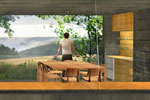
The second-place winner was Wendell Burnette Architects. Their proposal would be above ground, but integrated nonetheless among the forest. Wendell Burnette Architects
The participating firms, each known for environmental sensitivity, are Marlon Blackwell Architect, Fayetteville, Ark.; Wendell Burnette Architects, Phoenix, Ariz.; MacKay-Lyons Sweetapple Architects, Halifax, Nova Scotia; Olson Kundig Architects, Seattle, Wash.; Patkau Architects, Vancouver, British Columbia; and Saucier + Perrotte Architectes, Montreal, Quebec
Each practice was allowed four 24-inch-by-36-inch boards and one model representing a typical cottage unit. The firms were encouraged to give their own unique spin on it, with the additional goal of creating a sustainable design.
Intended to house students and/or teachers during onsite residency programs, the structures were planned to be LEED-certified platinum, which is energy efficient, site sensitive and low-maintenance. All of this in a tidy little package of about 700 square feet, including a small kitchen, open space with a fireplace and a bathroom.
“The architects were challenged to critically engage Wright’s formidable legacy and to address contemporary concerns regarding ecology and sense of place,” says Raymund Ryan, curator of architecture at the Heinz Architectural Center, and one of eight members of the competition jury.
The jury chose the entry of Patkau Architects as the winner of this first-ever design competition. Their model is located in the center of the exhibit.
Established in 1978, the firm has built many houses, schools and cultural institutions in British Columbia, structures characterized by articulate detailing, sheltering roofs and close attention to site.
Across Canada, Patkau Architects also are responsible for the Canadian Clay and Glass Gallery in Waterloo, Ontario, and the Grande Bibliotheque de Quebec in Montreal. For Fallingwater, they envisage sections of standard steel covered in fill, as “an intensification of the swelling ground-plane of the meadow.”
Here, their design shows that the juxtaposition of the project to Fallingwater is not as important as the juxtaposition of the project to the landscape, being that it proposes building the cabins into the rolling hillside. “It is of the hill, not on the hill,” Ryan says.
At first glance, it appears to be the most simple of all six on display. But look closer, and it’s easy to see why this proposal stood out for the jurors. It could be one or two units or even eight or nine. It is a natural system and has a collective quality.
“It appears simple but is well-integrated and thoughtful,” Ryan says. “It will be a fantastic, unique experience inside.”
The second-place winner was Wendell Burnette Architects. Their proposal would be above ground, but integrated nonetheless among the forest.
Like the Patkau design, the basic design could be expanded into multiple units. “Each cottage would be quiet, modest, but important in its conversation with nature,” Ryan says. “The architecture is not deferential, but respectful.”
The design of Olson Kundig Architects was chosen as the third-place winner.
Highlighting two aspects of the landscape surrounding Fallingwater — the forests and the fields — the project considers flow of people as well as the flow of land. “The unit is a response to how people gather and suggests how landscapes can be gathered and bridged,” Ryan says.
All three of these designs incorporate the use of energy-efficient and environmentally friendly building materials. Each of these cottages would be situated to take full advantage of natural heating and cooling opportunities and to minimize environmental impacts. Plus, each could be easily maintained during three seasons and just as easily closed over the winter.
Patkau Architects’ winning design for six small, efficient, sustainable cottages will serve as the basis of a final design, to be implemented following regulatory approval and fundraising.
These new cottages will serve an important outreach goal by expanding lodging capacity for participants in Fallingwater Institute’s diverse educational programs.
‘Design Competition: New Cottages at Fallingwater’When: Through Aug. 22. Hours: 10 a.m.-5 p.m. Tuesdays-Saturdays; until 8 p.m. Thursdays; noon-5 p.m. Sundays
Admission: $15; $12 for senior citizens; $11 for children and students; free for age 2 and younger
Where: Heinz Architectural Center at Carnegie Museum of Art, 4400 Forbes Ave., Oakland
Details: 412-622-3131 or website



